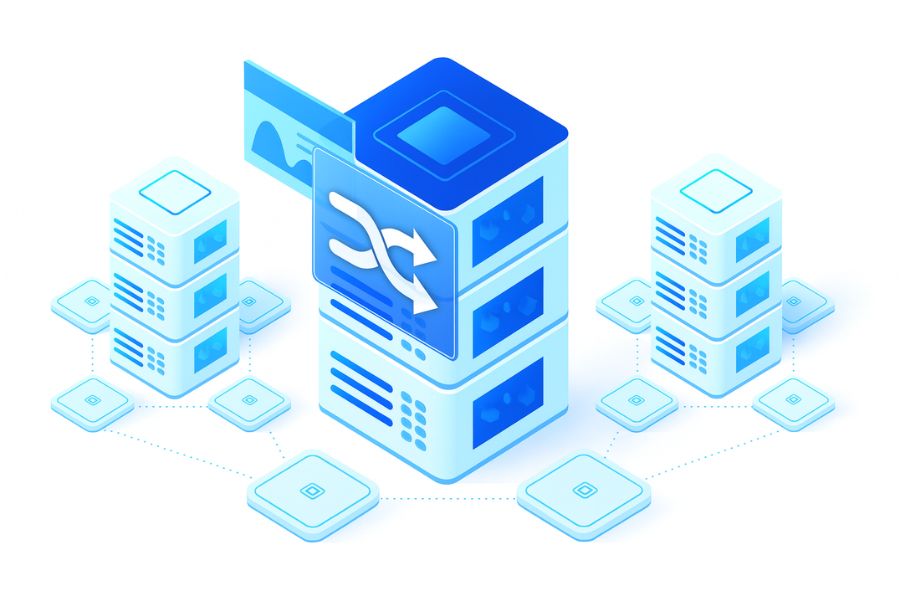
In today’s digital-first economy, downtime is no longer an option. DDoS attacks have evolved far beyond simple bandwidth floods, and by 2025, European businesses face multi-vector campaigns that combine volumetric, protocol, and application-level (Layer 7) floods capable of taking down even the most resilient platforms. Attackers now deploy massive botnets that can deliver terabits of traffic per second, often targeting login portals, APIs, payment gateways, or DNS infrastructure to maximize disruption.
Industries such as finance, gaming, SaaS, and eCommerce are particularly at risk because their customers demand uninterrupted access. Just a few minutes of downtime can translate into thousands of euros in lost revenue, reputational damage, and customer churn. This reality makes DDoS protection strategy a mission-critical business decision rather than a purely technical choice.
The central debate for IT leaders is whether to invest in remote DDoS protection, delivered by global cloud-based DDoS mitigation service providers through scrubbing centers and DDoS protection proxies, or to deploy on-premises appliances that filter attacks directly inside their own infrastructure. To make the right decision, businesses must carefully compare scalability, cost, latency, and compliance particularly under GDPR and NIS2 regulations that shape Europe’s cybersecurity landscape.
What Is Remote DDoS Protection?
Remote DDoS protection refers to a cloud-based security service where malicious traffic is filtered outside your own infrastructure before it ever reaches your servers. Instead of relying solely on in-house appliances, businesses partner with DDoS mitigation service providers who operate global scrubbing centers. When an attack begins, all incoming traffic is rerouted through a DDoS protection proxy, where advanced filtering techniques separate legitimate requests from malicious ones. Only clean traffic is forwarded back to the business, ensuring uptime and performance even during massive floods.
The biggest advantage of this approach is scalability. Remote services can handle terabit-scale attacks without requiring enterprises to purchase costly hardware upgrades. They also provide 24/7 SOC monitoring, meaning security experts are watching and responding in real time a huge relief for companies without large IT teams.
A question many businesses ask is, “Is a dedicated server better than VPS?” The answer is yes. Dedicated servers integrate more effectively with remote DDoS protection because resources are not shared, allowing traffic filtering rules to be fully customized to one environment. VPS servers, by contrast, may be affected by noisy neighbors, reducing mitigation effectiveness.
What Is On-Premises DDoS Protection?
On-premises mitigation uses hardware appliances or software installed inside a business’s own data center. Firewalls, intrusion prevention systems, and filtering appliances directly inspect incoming traffic.
Advantages include:
- Full control over filtering rules and logs.
- Immediate visibility into network activity.
- Compliance suitability for regulated industries (finance, healthcare).
A technical concern often arises: “What is the best CPU for a dedicated server?” For on-prem appliances, high-core processors like AMD EPYC or Intel Xeon Scalable are critical, as they allow packet inspection at line speed while maintaining service performance.
Key Differences Between Remote and On-Premises Solutions
- Deployment Model:
- Remote solutions rely on cloud-based scrubbing centers and DDoS protection proxies that filter traffic before it reaches the server.
- On-premises solutions use local appliances installed in the data center to inspect packets directly.
- Remote solutions rely on cloud-based scrubbing centers and DDoS protection proxies that filter traffic before it reaches the server.
- Latency Impact:
- Remote protection may add slight latency since traffic is routed through scrubbing centers.
- On-premises filtering is faster for local traffic because inspection happens within the network.
- Remote protection may add slight latency since traffic is routed through scrubbing centers.
- Scalability:
- Remote services can absorb multi-terabit floods with virtually unlimited capacity.
- On-premises solutions are constrained by hardware and available uplink bandwidth.
- Remote services can absorb multi-terabit floods with virtually unlimited capacity.
- Cost Structure:
- Remote = OPEX, predictable monthly subscription fees.
- On-premises = CAPEX, heavy upfront investment plus maintenance costs.
- Remote = OPEX, predictable monthly subscription fees.
Executives often ask, “Is dedicated IP faster?” The answer is yes. Dedicated IPs offer stable connections and protect reputation, especially when routed through DDoS protection proxies.
Benefits of Remote DDoS Protection for European Businesses
For SMEs and enterprises alike, remote DDoS protection offers clear advantages:
- Always-on defense across European geographies.
- Cost-effective scalability for businesses without large IT teams.
- Integration with VPS, dedicated servers, and cloud hosting without heavy investments.
A common question is, “Does Contabo VPS have GPU?” While some VPS providers do offer GPU, GPUs are irrelevant for DDoS defense. Remote protection provides the true safeguard, filtering malicious requests before they reach your infrastructure.
Benefits of On-Premises DDoS Mitigation
For certain European businesses, on-premises DDoS mitigation offers advantages that remote solutions cannot fully match.
- Full control: Companies manage their own appliances, filtering rules, and logs without third-party dependency. This provides transparency into every packet inspected.
- Data sovereignty: For financial institutions, government agencies, or healthcare providers, keeping sensitive data within local infrastructure is a compliance requirement. On-premises filtering ensures logs and attack data remain under direct control.
- Regulatory compliance: Frameworks like GDPR and NIS2 often push critical industries toward local control models. On-prem appliances allow businesses to demonstrate security ownership during audits.
- Custom configuration: Enterprises can fine-tune hardware appliances to their unique applications, achieving precise protection at the network edge.
A common question is, “What is the best dedicated IP provider?” The answer is European hosts with RIPE-assigned IP ranges and SOC-backed networks NexonHost being a leading choice.
Hybrid Approaches: Combining Remote & On-Premises Defense
As attacks grow more sophisticated, many European enterprises adopt a hybrid DDoS protection strategy that blends the strengths of both models.
- Remote scrubbing centers absorb massive volumetric floods that could easily overwhelm on-premises appliances. By filtering malicious traffic at scale, they ensure business continuity during large botnet-driven events.
- On-premises appliances complement this by providing precise application-level filtering and compliance controls, which are critical for industries like banking, healthcare, and government.
- This dual setup reduces reliance on a single defense layer, creating a multi-tiered security posture that is resilient against evolving threats.
Businesses often ask, “Which type of server is best?” The answer is clear: a dedicated server in Europe equipped for hybrid integration. By pairing remote DDoS protection proxies with local filtering appliances, companies achieve both scalability and control a balance that pure cloud or on-prem solutions alone cannot deliver.
Cost Considerations in Europe
The financial impact of downtime in Europe averages €200,000 per hour (IDC). Choosing the right DDoS protection model is a cost–risk calculation.
- Remote Protection: Predictable monthly subscription, scalable, no hardware maintenance.
- On-Premises: High upfront investment, requires skilled IT teams, ongoing upgrades.
During planning, businesses often ask, “What is the best server for storage?” The answer is dedicated storage servers with RAID and ZFS for forensic logs during attacks, ensuring data is preserved for compliance and incident response.
Compliance & Regulations (GDPR, NIS2)
European regulations such as GDPR and NIS2 impose strict requirements on how data is stored, processed, and protected. For businesses evaluating DDoS strategies, compliance is just as important as performance.
- Remote Protection: Enterprises must verify that scrubbing centers are located within the EU to ensure data sovereignty. Using providers outside Europe can create legal risks if user data passes through non-compliant jurisdictions. Top DDoS mitigation service providers in Europe advertise GDPR alignment and EU-based proxies to minimize exposure.
- On-Premises: Since all logs and filtering take place within a company’s infrastructure, data remains under local control. This makes it attractive for banks, fintech firms, and healthcare organizations. However, it requires ongoing maintenance, patching, and audits to stay compliant.
A frequent query is, “How much does Bluehost cost?” While low-cost hosts charge €20–30/month, they cannot deliver EU-compliant DDoS protection, making them unsuitable for regulated businesses.
Real-World European Case Studies
Romanian Fintech (On-Premises): Adopted local filtering appliances to meet strict financial compliance. Attacks were mitigated but required heavy investment in IT staff.
Dutch eCommerce Retailer (Remote): Integrated with a DDoS protection proxy that filtered traffic through Amsterdam scrubbing centers. Black Friday attacks were absorbed seamlessly.
German SaaS Startup (Hybrid): Used remote scrubbing for volumetric attacks and local appliances for Layer 7 filtering. Achieved high uptime and GDPR compliance.
In these scenarios, businesses often ask, “What is the most reliable server?” The answer is a dedicated server with integrated DDoS mitigation and premium European network routes.
Choosing the Right Approach for Your Business
Selecting the best DDoS protection strategy depends heavily on the size, industry, and risk profile of your business.
- SMEs (Small and Medium Enterprises): Remote DDoS protection is usually the right fit. It provides scalability, predictable monthly costs, and minimal IT overhead, which is ideal for companies without in-house security teams.
- Enterprises in regulated industries: Financial services, government, and healthcare providers often favor on-premises or hybrid models. These solutions allow them to retain local data control, align with GDPR/NIS2, and meet strict compliance audits.
- Gaming, SaaS, and high-traffic eCommerce: These industries benefit most from a hybrid approach, combining the scale of remote scrubbing centers with the low latency of on-prem appliances to protect APIs, logins, and customer transactions.
Executives often ask, “How much does a dedicated server cost?” In Europe, budget €150–€400 monthly for premium dedicated servers with integrated DDoS mitigation features.
Building Resilience With the Right Model
There’s no one-size-fits-all answer. Remote DDoS protection is ideal for SMEs and cost-sensitive companies needing scalability. On-premises solutions suit heavily regulated enterprises needing local control. Hybrid setups provide the strongest balance, handling volumetric floods and application-level threats simultaneously.
Two final questions are common:
- “Do you need a good GPU to run a dedicated server?” No. GPUs don’t matter for DDoS mitigation CPUs, proxies, and scrubbing capacity matter.
- “Which is the best server in the world?” The best server is the one optimized for uptime, integrated with low-latency proxies, and tailored to your business needs in Europe, that means NexonHost.
In 2025, resilience is the differentiator. Choosing the right DDoS protection model ensures your business stays online, secure, and trusted no matter the scale of attack.

